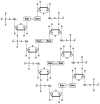Comparison of Polynucleotide and Polydeoxyribonucleotide in Dermatology: Molecular Mechanisms and Clinical Perspectives
- PMID: 40871045
- PMCID: PMC12388916
- DOI: 10.3390/pharmaceutics17081024
Comparison of Polynucleotide and Polydeoxyribonucleotide in Dermatology: Molecular Mechanisms and Clinical Perspectives
Abstract
Polynucleotide (PN) and polydeoxyribonucleotide (PDRN) are DNA-derived biopolymers increasingly recognized for their potential in dermatology. Despite their structural similarities, PN and PDRN exhibit distinct functions due to differences in polymer length and molecular weight. PN, composed of longer DNA fragments, plays a key role in extracellular matrix remodeling. Conversely, PDRN, composed of relatively shorter oligonucleotide sequences than those of PN, enhances skin condition through adenosine receptor activations and supports nucleotide synthesis via both the salvage and de novo pathways. This review provides a critical comparison of the molecular characteristics and functions of PN and PDRN with particular emphasis on their dermatological applications. By delineating their respective roles in esthetic and regenerative medicine, we aim to highlight recent advances that may guide the development of optimized treatment strategies and foster evidence-based clinical practice.
Keywords: dermatological applications; polydeoxyribonucleotide; polynucleotide.
Conflict of interest statement
The author declares no conflicts of interest.
Figures
References
Publication types
Grants and funding
LinkOut - more resources
Full Text Sources



